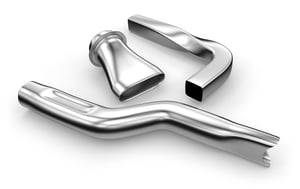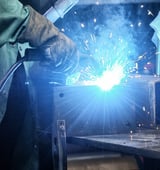Designing and fabricating manufacturing-related tools — dies, molds, patterns, jigs, fixtures and so on — in ways that maximize efficiency while also minimizing cost is commonly referred to as “agile tooling,” and it is an important trend for modern manufacturing.
Techniques used to create an agile tooling environment range from the traditional to the cutting-edge. These may include the following:
 Die stamping is a traditional process in which raw material such as sheet metal is placed into a press and formed into a shape. The stamping category encompasses a variety of cold-forming techniques, including bending, embossing, flanging and punching. The process can also be used on materials such as polystyrene.
Die stamping is a traditional process in which raw material such as sheet metal is placed into a press and formed into a shape. The stamping category encompasses a variety of cold-forming techniques, including bending, embossing, flanging and punching. The process can also be used on materials such as polystyrene.
Hydroforming is a specialized die stamping technique used frequently by the automotive industry to shape metals into sturdy, lightweight forms. Hydroforming makes use of a high-pressure hydraulic fluid to press raw materials into molds that serve as a negative image of the desired result. The technique expands the possibilities for creating complex, curved shapes.
 Die casting is a metalworking process dating back thousands of years, involving molten metal poured into a three-dimensional negative image mold. In manufacturing, the technique is especially suited for making large quantities of small- to medium-sized parts with dimensional consistency. Die casting is a type of injection molding, which is a process that can also be applied to glass, polymers and plastics.
Die casting is a metalworking process dating back thousands of years, involving molten metal poured into a three-dimensional negative image mold. In manufacturing, the technique is especially suited for making large quantities of small- to medium-sized parts with dimensional consistency. Die casting is a type of injection molding, which is a process that can also be applied to glass, polymers and plastics.
Thermoforming is a molding process that involves heating plastic sheets to pliable temperatures and forming them in molds. A commonly used version of the process uses a vacuum to force the heated plastic against the mold. Thermoforming can represent a faster, lower-cost alternative to techniques such as plastic injection molding.
 Welding involves joining materials such as metal, glass or plastic by melting them together and allowing them to fuse through cooling. There are several types of welding methods incorporating different heat sources for melting materials, as well as differing capacities for being performed automatically or semi-automatically. A significant percentage of robots in industrial settings are used for arc welding, which employs electricity as a heat source.
Welding involves joining materials such as metal, glass or plastic by melting them together and allowing them to fuse through cooling. There are several types of welding methods incorporating different heat sources for melting materials, as well as differing capacities for being performed automatically or semi-automatically. A significant percentage of robots in industrial settings are used for arc welding, which employs electricity as a heat source.
CNC machining is the operation of devices to shape and form raw materials by computer numerical control (CNC), enabling the achievement of precise tolerances. CNC may be employed in a variety of machining processes such as milling, lathing, routing and so on – basically, any process that can be described as a series of movements and operations. The common denominator among CNC machines is their ability to  follow preprogrammed instructions from CAD files and without a manual operator.
follow preprogrammed instructions from CAD files and without a manual operator.
Additive manufacturing is the use of 3D-printing processes to produce complex objects from basic building blocks such as polymer filaments or grains of powder. As with CNC machines, digital instructions drive the operation of additive manufacturing (AM) equipment; whereas machining removes excess raw material to produce finished products, AM transforms materials into new shapes and geometries by building layer upon layer. There are several types of AM techniques in use, including fused filament fabrication (FFM), the thermoplastic printing process commonly used by hobbyists; stereolithography (SLA), the light-based process of transforming resins into polymers; and selective laser sintering (SLS), the powder-based fusion process that expands both the geometric and material possibilities.
While each of these processes is distinct, a significant amount of overlap exists throughout industry. This overlap, in fact, can be considered a measure of agility. Parts made via stereolithography are strong enough to be used for making master patterns for injection molding, for instance. Tooling created by vacuum forming can be accomplished more quickly and cost-effectively by incorporating FFM devices to produce the raw plastic. CNC machining, which began with the first automated lathe seven decades ago, can now be used for practically any tooling process imaginable.
The future is liable to continue to bring innovation into agile tooling, along with increased opportunities to streamline manufacturing operations through well-informed capital investment.
Contact Radwell International to learn more about buying, selling and repairing a wide range of manufacturing equipment designed to empower success.
To learn more about Radwell International, 

